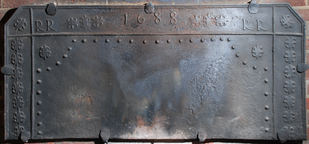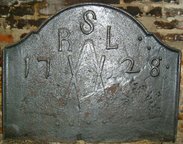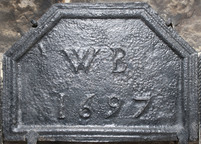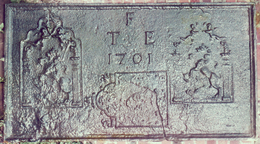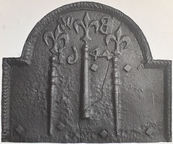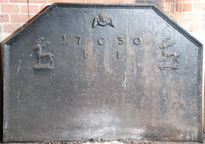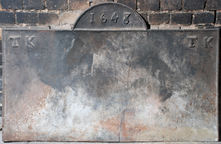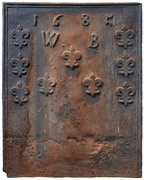-
884
Description: Canted rectangle; stepped fillet edging (top and sides); twisted rope lengths parallel to top and parallel to each side, forming six compartments; side compartments: seven double fleurs-de-lys in vertical line; top corner compartments: one double fleur-de-lys angled parallel to canting; top compartment: date in centre, initials repeated at each end, three fleurs between date and initials, centre fleur perpendicular to others; main compartment: one fleur in each top corner, line of beads inside rope line, arc at corners.
Notes: The arc shape and use of repeated beads suggests a common source with other firebacks of the same period.
Inscription: RR / 1688 / RR
- Decoration tags:
- rectangular with canted top corners (shape)
- stepped fillet (edging)
- simple stamps
- carved stamps
- individual letters
- individual numbers
- heraldic
- text
- objects
Manufactured: in 1688 in the Forest of Dean area of England.
Current location: The George Hotel, Stone Street, Cranbrook, Kent, England.
- Attached to series:
- Date & initials firebacks
- Newent area group
- Square cross Dean series 2
-
39
Description: Quasi-arched rectangular shaped with cavetto canted top corners; fillet edging; two V-shaped arrangements of laths, one inverted and superimposed over the other, in centre of plate; date split on either side; initials in triangular arrangement above laths.
Notes: The shape of the fireback is very similar to firebacks at Knole, Sevenoaks, of similar date, and may be the product of the same furnace; the 'X' shapes may have apotropaic significance.
Inscription: 17 RSL 28
- Decoration tags:
- rectangular with canted top corners and round arch (shape)
- fillet (edging)
- simple stamps
- individual letters
- individual numbers
- apotropaic
- text
- objects
Manufactured: in 1728 in the Weald area of England.
Current location: Cranbrook Museum, Cranbrook, Kent, England.
- Attached to series:
- Date & initials firebacks
-
1112
Description: Canted rectangular shape; individual moulded edging; centre, initials WB, above date.
Notes: The text appears to have been imprinted into a mould formed from a base panel.
Inscription: WB / 1697
- Decoration tags:
- rectangular with canted top corners (shape)
- complex individual (edging)
- carved stamps
- individual letters
- individual numbers
- text
Manufactured: in 1697 possibly in the Weald area of England.
Current location: in private hands, Crowborough, East Sussex, England.
- Attached to series:
- Date & initials firebacks
-
911
Description: Plain rectangular plate; no edging; top centre, date with '7' reversed; below date, initials in triad.
Notes: The reversed '7' indicates that the numerals, and probably the letters, had no backing; the initials are probably those of a husband and wife whose surname began with 'H'.
Inscription: 1676 / BHM
- Decoration tags:
- rectangular (shape)
- none (edging)
- carved stamps
- individual letters
- individual numbers
- text
Manufactured: in 1676 in the Weald area of England.
Current location: in private hands, Crowhurst, East Sussex, England.
- Attached to series:
- Date & initials firebacks
-
1011
Description: Rectangular shape with cavetto-moulded edging; top centre, initials in triad with date below; on each side, stamp formed of a small, wavy-arched rectangular fireback bearing a lion rampant between pilasters surmounted by burning cauldrons, beneath two mirrored putti holding branches; beneath the date, a stamp formed of a small arched-rectangular fireback laid on its left side with a burning cauldron on each shoulder and the faint figure of a bird in the centre.
Notes: The two identical fireback stamps on either side of the inscription have been noted elsewhere (see no. 210 Late Pictorial series 5); the centre and right fireback stamps have been impressed insufficiently; illustration from Country Life advertisement by T. Crowther & Son Ltd, 18 Oct 1984.
Inscription: TFE [triad] / 1701
- Decoration tags:
- rectangular (shape)
- cavetto (edging)
- composite
- individual letters
- individual numbers
- pictorial
- architectural
- text
- animals
Manufactured: in 1701 in England.
Current location: not known.
-
340
Description: Arched rectangular shape; gadrooned edging (top and sides); initials, in separate stamps, at top of arch; date in separate stamps, split by central spindle, below; two different spindles used as stamps, one centrally between splitting initial stamps, the other repeated twice on each side, slightly lower; above each spindle a fleur-de-lys stamp.
Notes: It is possible that the initials were intended to be 'BW' but that it was forgotten that they needed to be reversed when impressed into the mould. The same base board has been used for other firebacks dating from 1622 and 1632, and the central spindle can be be seen on another fireback of 1644. Purchased by J. H. Every at Bigges Farm, Cuckfield, Sussex, in 1918.
Inscription: W B / 16 44
- Decoration tags:
- rectangular with round arch (shape)
- gadrooned (edging)
- simple stamps
- individual letters
- individual numbers
- text
- objects
Manufactured: in 1644 possibly at Cuckfield Furnace in the Weald area of England.
Current location: not known.
Citation: Hughes, G. B., 21 Apr 1955, 'Old English Firebacks', Country Life, 117, pp. 1056-60.
Citation: Hughes, G. B., May 1940, 'Old English Firebacks', Apollo, 31, 185, pp. 117-120.
- Attached to series:
- Spindle series
- Spindle/distaff firebacks
- Date & initials firebacks
-
47
Description: Rectangular with canted top corners; ovolo-moulded edging (except base); top centre, cherub face and wings; below, date separated by initials in triad on either side of which a stag statant on a chapeau.
Notes: The cherub is similar, but not identical to those on a fireback, of 1713, from Ashburnham, and the layout and edging are also similar.
Inscription: 17 ICI [triad] 30
- Decoration tags:
- rectangular with canted top corners (shape)
- ovolo (edging)
- carved stamps
- individual letters
- individual numbers
- heraldic
- text
- animals
- humans
Manufactured: in 1730 possibly at Ashburnham Furnace in the Weald area of England.
Current location: in private hands, Cuckfield, West Sussex, England.
- Attached to series:
- Date & initials firebacks
- Miscellaneous stamp firebacks
-
273
Description: Rectangular with twisted rope edging top and sides; central arch with twisted rope edging; date in arch (8 with flattened top); initials repeated in top corners.
Notes: An unusually large plate to have such simple decoration.
Inscription: 1648 / TK TK
- Decoration tags:
- rectangular with round arch (shape)
- rope (edging)
- individual letters
- individual numbers
- text
Manufactured: in 1648 in England.
Current location: in private hands, Dorton, Buckinghamshire, England.
- Attached to series:
- Date & initials firebacks
-
291
Description: Rectangular; astragal with cavetto-moulded edging (top and sides); date top centre; initials evenly-spaced below date; low-relief fleur de lys stamp repeated three times down each side, and in triangular arrangement below initials.
Notes: The initials may relate to William Boevey who was owner of Flaxley furnace from 1683-92. Another fireback with the same date and initials, and fewer fleurs, is also known. Formerly at Flaxley Abbey, Gloucestershire. Dreweatts Auctioneers, Newbury, 3 Oct 2022, lot 183 (£240).
Inscription: 1685 / W B
- Decoration tags:
- rectangular (shape)
- astragal with cavetto (edging)
- carved stamps
- heraldic
- text
Manufactured: in 1685 at Flaxley Furnace in the Forest of Dean area of England.
Current location: not known.
Citation: Bick, D. E. [incorrectly printed as Bick, R.], Sept 1985, 'Firebacks', Period Homes, pp. 21-4.
- Attached to series:
- Boevey series
- Date & initials firebacks
-
1177
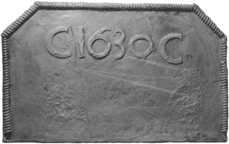 ? x ? mmImage subject to copyright
? x ? mmImage subject to copyrightDescription: Canted rectangular shape; twisted rope edging (top and sides); top centre, inscription 'C1630C'.
Notes: In the inscription, the letter 'C' may have been formed from a horseshoe. The fireback was discovered in 1959 at the works of Samuel Lewis & Co. Ltd. at Netherton, Worcestershire. It has been suggested that it was probably made by Walter Chetwynd, tenant of the ironworks at Cannockwood in Staffordshire who is mentioned as such in accounts of 1636 and 1637 made by Roger Jones received for William, Lord Paget of Beaudesert, the owner of the works.
Inscription: C1630C
- Decoration tags:
- rectangular with canted top corners (shape)
- rope (edging)
- simple stamps
- carved stamps
Manufactured: in 1630 possibly in the Cannock Chase area of England.
Current location: not known.
- Attached to series:
- Date & initials firebacks
